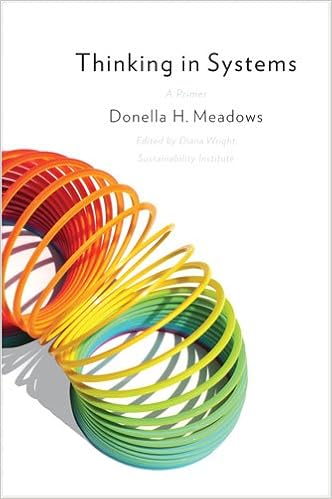
Thinking in Systems is the best introduction to systems thinking available. The word "Thinking" in the title is critical. At the end of the book you can clearly see the world structured and organized in terms of systems - - from waiting in the TSA screening line at the airport to the economics of gasoline prices. The world is increasing dominated by complex systems requiring engineers skilled in system thinking.
All engineers, not just industrial engineers, should read the book for the following reasons:
- Systems Complexity Dominates the World - I flew to New York City last weekend. LaGuardia Airport is a living textbook on systems complexity. From landing to catching a cab, the entire experience requires a systems mental model. To be managed effectively, you need an understanding of the numbers, buffers, stock-and-flow structures, delays, balancing feedback loops, reinforcing feedback loops, information flows, rules, goals, and paradigms. The systems are just too complex to be managed effectively without systems thinking. Hour waits in the TSA check lines are a great example where a lack of systems thinking has eroded the effectiveness of the complete system. LaGuardia is just one example, but the ability to think in terms of systems and complexity is critical for anyone hoping to run a successful company, community, country, or organization.
- Systems Thinking Is Needed for a New World Dominated by Sustainability and Resiliency - Sustainability and resiliency in the context of urban infrastructure represents the yin and yang of systems complexity. I was watching the America's Cup raising on the Hudson River last Sunday. All that water made me think about a NYC future of even more water from extreme weather events and rising sea levels. You can make that area of NYC really resilient - just build a 10-foot high sea wall. But what you gain in resiliency you subtract in sustainability - the idea of looking at environmental, economic, and social considerations over multi-generations. The more resilient you deign, the less sustainable it becomes and the more sustainable you design, the less resilient it becomes. Balancing a world of both resiliency and sustainability will require thoughtful systems thinking.
- The Boundaries of Our Systems Keeps Expanding - Riding the NYC subway is a good illustration of our expanding views of systems. Designing and managing a transit system goes beyond moving X number of people from Point A to Point B as it was in 1915. You have new social and cultural systems to consider. Security is a 2016 concern - - which makes up a large sub-system with critical interface points. You have maintenance and resiliency systems that are mission critical. One subway station probably has hundreds of interface points with other systems in NYC. These interface point will only grow with time. Understanding this complexity will require at least some engineers with a firm understanding of systems thinking and systems mental models.
No comments:
Post a Comment
Note: Only a member of this blog may post a comment.